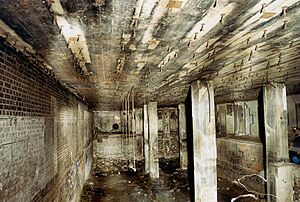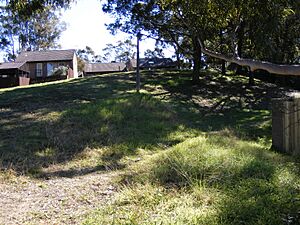Bankstown Bunker facts for kids
The Bankstown Bunker was a top-secret base for the Royal Australian Air Force during World War II. It was Australia's main air defence base back then. Today, it's no longer used and is hidden under a park in Condell Park, New South Wales, Australia. You can still find a secret way to get inside!
Contents
What Was the Bankstown Bunker?
The Bankstown Bunker was a three-story building, mostly built underground. It was used secretly by the Australian Air Force during World War II. Construction started in 1942. Workers and volunteers began working inside the bunker in January 1945.
It was known as the Sydney "Air Defence Headquarters." Its main job was to track all planes in the eastern part of the South West Pacific. People worked there 24 hours a day, seven days a week, in shifts. They traveled to work on buses with tinted windows. Everyone working in the bunker had to get special training.
Some people who worked there were from:
- The No.2 Volunteer Air Observer Corps (VOAC)
- The Women's Auxiliary Australian Air Force
- The Royal Australian Air Force
- The United States Army Air Forces
After the war ended, the bunker was no longer used. People forgot about it for a while. In 1971, a reporter found it again. Sadly, in 1972, the bunker was set on fire. Later, in 1976, houses were built over part of the building. The main part is still hidden under a public park.
Inside the Secret Bunker
The Bankstown Bunker was built like the underground Operations rooms in wartime England. These rooms helped plan Britain's air defence against German planes.
To get inside the bunker, you had to use a secret entrance. It was hidden under a grassy hill. Stairs led down to many hallways that went to different areas. There were two entrances, both guarded by special military police.
The bunker walls were very thick, about 1.5 metres (5 feet). This made it almost bomb-proof. It had all the best equipment of that time. It was a top-secret defence base with many rooms, including:
- A code room
- Plotting rooms
- Two escape tunnels
- A radio transmitter room
- A kitchen and dining area
- Bathrooms and bedrooms
In the middle of the bunker was a large operations room. This room was about two stories high. It was the control centre for all air force missions in the Pacific area. It also had a huge map of the South West Pacific theater of World War II.
The bunker had its own power generator, air conditioning, and switchboards. These switchboards managed 50 telephone lines. These lines connected to radar stations and lookout posts. These posts reported where aircraft were to the bunker. There are also stories about a secret tunnel from the bunker to an unknown place.
Where is the Bunker Today?
The bunker is under a small park at the end of Taylor Street. In this park, there is a large hill that looks a bit out of place. The bunker is buried under this hill. It is still possible to get inside through a secret door.
Other Bunkers in Bankstown
There are rumours of other hidden bunkers in the Bankstown area. One is called a "Remote Receiving Station." Not much is known about its history. It was in Picnic Point National Park, near the South Sydney Power station. People who live nearby say it might still be there.
There are also stories about other bunkers:
- Under an electricity block house at Milpera Road and Henry Lawson Drive.
- A bunker that was demolished under Condell Park High School.
The Bankstown Bunker on TV
The Bankstown Bunker was once featured on a TV show called Burke's Backyard. The host, Don Burke, filmed an episode from inside the bunker. He used the secret passageway to get in.
Images for kids







